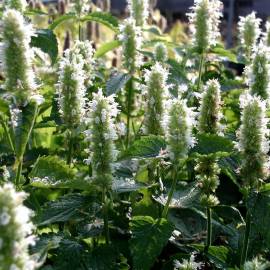




«Purple King» - Echinacea purpurea Seeds
1.14 €
Easily grown in average, dry to medium, well-drained soil in full sun to part shade. Best in full sun. An adaptable plant that is tolerant of drought, heat, humidity and poor soil. Divide clumps when they become overcrowded (about every 4 years).
-
Echinacea purpurea «Purple King»
Easily grown in average, dry to medium, well-drained soil in full sun to part shade. Best in full sun. An adaptable plant that is tolerant of drought, heat, humidity and poor soil.
Divide clumps when they become overcrowded (about every 4 years). Plants usually rebloom without deadheading, however prompt removal of spent flowers improves general appearance. Freely self-seeds if at least some of the seed heads are left in place.
Purple Coneflowers are quintessential prairie plants. They are hardy, drought-tolerant, long-blooming, and are being cultivated in an ever-widening range of colors. It's hard to find a garden without at least one variety. Echinacea is a native North American genus with about 10 species. Not all make great garden plants. Echinacea purpurea is by far the most popular coneflower.
It has a more fibrous root system, rather than the long tap root and woody crown found in other wilder species, and is more adaptable to garden conditions and more forgiving of dividing and transplanting.
Flowers: Coneflower's daisy-like flower is actually made up of several small flowers. The petals are sterile and are there to lure insects toward the many fertile flowers in the central disk or cone. These flowers are rich in nectar and very popular with both bees and butterflies.
Flowers used to only be some shade of purple or lavender, with a dark center cone. Much hybridization has been taking place and you can now find petal colors ranging from white to green through yellow, orange and deep reds.
The common name "coneflower" refers to the way the petals angle backward, away from the center, forming a cone.
Foliage: Growth starts with a clump of basal leaves, which eventually send up flower stems in mid-summer.
The leaf shape depends on the variety. Many have oval leaves with a wide base, but some from dry, western areas often have narrow leaves.
Products Viewed Before
0.96 €
1.14 € (Sale: 15%)
This is an early variety, 95-105 days. Transportable and long-term storage. Plant is compact, determinate 45-50 cm. The fruit is round, weighing 110-130 grams. The taste qualities are high. Relatively resistant to diseases. Universal use.
Product code: 12248
1.14 €
The humble White Currant really has proven to be an enduringly popular choice amongst British fruit gardeners, and it isn't difficult to see why. Celebrated for their high vitamin C content, currant berries make an excellent addition to a healthy diet.
Product code: 2152
1.14 €
Agastache foeniculum «Tibetan» looks ravishing in a border with its lovely creamy-white spikes held over a light-green aromatic foliage which exudes an anise scent when crushed. Its long flowering season and showy flower spikes.
Product code: 6772
1.14 €
A real storehouse of vitamins and mineral salts. The use of parsnip in food improves appetite, digestion, strengthens the walls of blood vessels, increases potency. They sow in the early spring with a row spacing of 45 cm to a depth of 2.5-3 cm.




